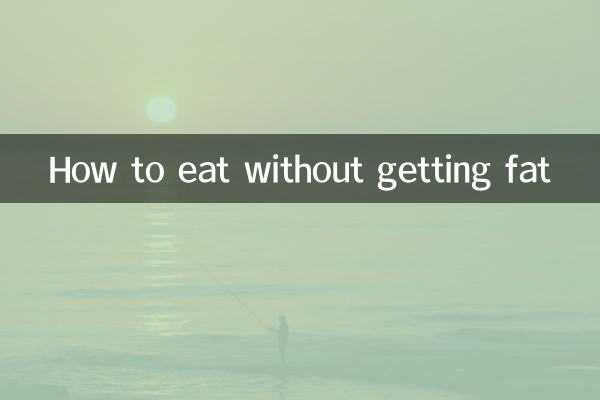How to eat without getting fat: analysis of scientific diet and hot topics
In recent years, healthy eating and weight management have become hot topics across the Internet. As the pace of life accelerates, how to stay in shape while enjoying delicious food has become the focus of many people's attention. This article will combine the hot topics and hot content in the past 10 days to provide you with a scientific and practical guide on "how to eat without getting fat".
1. Inventory of hot food topics on the Internet (last 10 days)

| Ranking | topic | heat index | core ideas |
|---|---|---|---|
| 1 | Light fasting method to lose weight | 9.8 | 16:8 Intermittent fasting is most popular |
| 2 | anti-glycation diet | 9.5 | Controlling refined sugar intake is key |
| 3 | High protein weight loss method | 9.2 | Increase satiety and reduce total intake |
| 4 | Probiotics and Gut Health | 8.7 | Improve intestinal flora to aid weight loss |
| 5 | Meal replacement food controversy | 8.5 | Experts advise choosing carefully |
2. Five scientific principles on how to eat without getting fat
1.Control total caloric intake: Daily caloric intake should be slightly lower than consumption, and it is recommended to control it at 1.1-1.3 times the basal metabolic rate.
2.Optimize diet structure: Adopt the combination mode of "high protein, appropriate amount of carbohydrates, and high-quality fat".
| Nutrients | Recommended ratio | quality source |
|---|---|---|
| protein | 25-30% | Chicken breast, fish, soy products |
| carbohydrates | 40-45% | Whole grains, cereals, vegetables |
| fat | 25-30% | Olive oil, nuts, deep-sea fish |
3.Choose low GI foods: Foods with a glycemic index below 55 are more conducive to weight control.
4.Pay attention to the order of eating: Eating vegetables first, protein second, and staple food last can significantly reduce postprandial blood sugar response.
5.Develop healthy eating habits: Chew slowly, eat three meals regularly, and drink plenty of water.
3. Recommendations for the recently popular “eat without fat” ingredients
| Ingredients | Calories (kcal/100g) | Features |
|---|---|---|
| Konjac | 7 | Ultra low calorie, high dietary fiber |
| chicken breast | 133 | High protein low fat |
| Broccoli | 34 | High nutrient density |
| salmon | 208 | Rich in Omega-3 fatty acids |
| chia seeds | 486 | High fiber, absorbs water and swells |
4. Analysis of recently hotly debated dietary misunderstandings
1."Zero sugar" does not mean healthy: Many sugar substitute products may stimulate appetite and lead to the intake of more calories.
2.Excessive pursuit of low-fat diet: Moderate amounts of high-quality fats are essential for hormone balance and nutrient absorption.
3.Superstition on single food for weight loss: Such as the "Apple Diet" may lead to nutritional imbalance.
4.Ignore invisible heat: The calories in condiments and drinks are often underestimated.
5. Examples of scientific diet plans
| Meals | Recommended combination | Calorie estimate |
|---|---|---|
| breakfast | Whole wheat bread + eggs + milk + vegetable salad | 350kcal |
| lunch | Multigrain rice + steamed fish + broccoli + mushroom soup | 450kcal |
| dinner | Chicken breast + quinoa + spinach salad | 400kcal |
| Extra meal | Sugar-free yogurt + a handful of nuts | 150kcal |
Conclusion:
The core of how to eat without getting fat lies in establishing scientific dietary concepts rather than extreme dieting. By properly combining ingredients, controlling total calories, and optimizing diet structure, everyone can find a healthy eating method that suits them. Various diets that have been hotly debated recently have their own pros and cons. It is recommended that you try them selectively based on your personal circumstances and consult a professional nutritionist for advice. Remember, a sustainable healthy diet is the long-term way to maintain your ideal weight.

check the details

check the details